Shintoism
- Details
- Written by AndEl
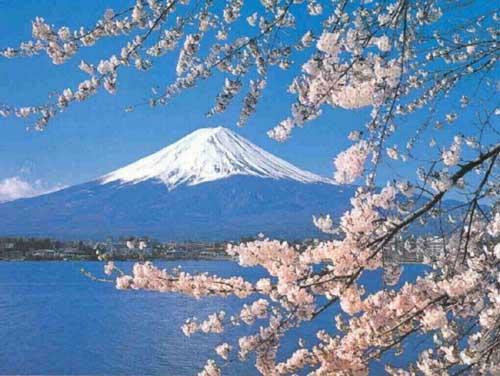
Shintoism - The Way of God
Shinto is the native religion in Japan with its roots stretching back to 500 B.C., and is a poly-theistic one venerating almost any natural object ranging from mountains, rivers, water, rocks, trees, to dead notables. In other words, it is based on animism. Natural wonders make the Japanese believe, out of an awe or reverence, that such wonders are created by the mighty, super-natural powers, and the ghost of a deity dwells in such objects. Also great warriors, leaders and scholars are often divinized. Thus anything, even a rotten head of a sardine, can be deified, so goes a cynical saying. To dedicate to those diverse deities, shrines were erected in sacred spots throughout Japan. Among the natural phenomena, the sun is most appealing to the Japanese and the Sun Goddess is regarded as the principal deity of Shinto, particularly by the Imperial Family. We Japanese call our nation 'Nippon' in Japanese. It literally denotes 'the Origin of the Sun'. The Japanese national flag is simple, one red disk in the center, and it symbolizes the sun.
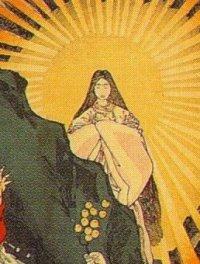 The Japanese mythology relates that there was the goddess of the sun and the ruler of the heaven named Amaterasu {pronounced ah-mah-teh-rah-soo}, who was believed to be the legendary ancestor of the current Imperial Family. It asserts that she was once so offended by the misdeeds of her brother that she came down to the earth and hid in a cave. The universe was plunged into pitch darkness and evil thrived. The gods and goddesses gathered near the cave to talk about how to get her out. They held a party and a goddess began to dance in front of the cave, causing the crowd to roar with delight. As she whirled about, her clothes fell off, drawing cheers from the other gods. Curious about the fuss, Amaterasu peeked out from behind a jumbo rock blocking the cave's entrance. The dancing goddess held up a mirror and said, "We are dancing to celebrate for a new goddess." Amaterasu came out to see the new goddess, but what she saw was her own reflection. A powerful god grabbed her out and told never to hide again.
The Japanese mythology relates that there was the goddess of the sun and the ruler of the heaven named Amaterasu {pronounced ah-mah-teh-rah-soo}, who was believed to be the legendary ancestor of the current Imperial Family. It asserts that she was once so offended by the misdeeds of her brother that she came down to the earth and hid in a cave. The universe was plunged into pitch darkness and evil thrived. The gods and goddesses gathered near the cave to talk about how to get her out. They held a party and a goddess began to dance in front of the cave, causing the crowd to roar with delight. As she whirled about, her clothes fell off, drawing cheers from the other gods. Curious about the fuss, Amaterasu peeked out from behind a jumbo rock blocking the cave's entrance. The dancing goddess held up a mirror and said, "We are dancing to celebrate for a new goddess." Amaterasu came out to see the new goddess, but what she saw was her own reflection. A powerful god grabbed her out and told never to hide again.
Today's Emperor Akihito {ah-key-he-toh} is said to be the 125th direct descendant of Emperor Jinmu {gin-moo}, Japan's legendary first emperor and a mythical descendant of Amaterasu. Though not often referred to today, the Japanese calendar year starts from 660 B.C., the year of his accession. The reigning emperors were considered to be the direct descendant of the Sun Goddess and revered as a living god at one time or another. When the Pacific War was imminent in 1940, the fascist government was boasting it was the year of 2600 to exalt the national prestige, and it even made a song celebrating the 2600th year.
With the introduction of Buddhism from China in the mid-sixth century, however, Shinto began to be overshadowed by Buddhism. Greatly affected by the new religion, Imperial Prince Shotoku {sho-tok} (574-622) institutionalized Buddhism as a state religion and built many great temples such as Horyuji in Nara Prefecture and Shiten'noji in Osaka. Many Buddhist temples today have a hall in which Prince Shotoku is enshrined in homage of his achievements. As a matter of fact, his portrait had been printed on the 10,000-yen bills until recently.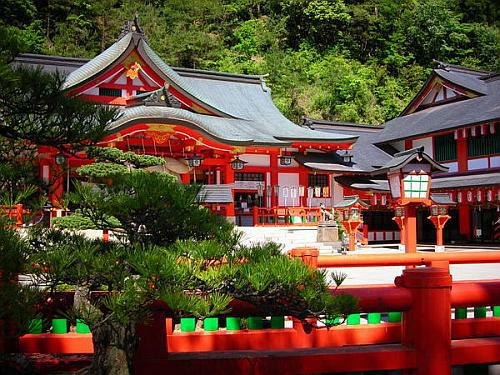 Entering the medieval ages, emperors and Shinto lost the reigning power and the nation was gradually controlled by the military rulers. The process of blending Buddhism with Shinto progressed, and in the Heian Period (794-1185) Shinto deities came to be recognized as incarnation of the Lord Buddha. The case in point was emerging of the syncretic school that combined Shinto with the teachings of the Shingon sect Buddhism. The basis of the school's belief was that Shinto deities were manifestation of Buddha divinities. Most important was the identification of the Sun Goddess Amaterasu with Buddha Mahavairocana or Dainichi Nyorai.
Entering the medieval ages, emperors and Shinto lost the reigning power and the nation was gradually controlled by the military rulers. The process of blending Buddhism with Shinto progressed, and in the Heian Period (794-1185) Shinto deities came to be recognized as incarnation of the Lord Buddha. The case in point was emerging of the syncretic school that combined Shinto with the teachings of the Shingon sect Buddhism. The basis of the school's belief was that Shinto deities were manifestation of Buddha divinities. Most important was the identification of the Sun Goddess Amaterasu with Buddha Mahavairocana or Dainichi Nyorai.
In the Kamakura Period (1185-1333), however, Shinto was emancipated from the Buddhism domination by the military dictators, and Shintoist claimed that Shinto divinities were not incarnation of the Buddha but that Buddha himself was rather manifestation of Shinto deities. Tsurugaoka Hachimangu Shrine used to be a typical mixture of Shinto and Buddhism elements and a prime example of syncretism as Yoritomo Minamoto {yo-re-toh-mo me-nah-moh-toh} (1147-1199), the founder of the Shrine, was in the lineage of the Imperial Family.
After the Meiji Imperial Restoration of 1868, the Emperor restored the sovereignty, and the new government institutionalized Shinto as the official state religion while implementing restrictive policies against Buddhism and other religions including Christianity. Tsurugaoka Hachimangu Shrine had to remove or throw away all of its structures and objects associated with Buddhism. The Emperor turned living god, and those who dared to gaze directly at the divine Emperor were subject to arrest. Some critics say it was more fascistic than today's North Korea since Kim Jong II is not divinized yet. Today's emperor is no longer a god, of course, but a symbol of the state and of the unity of the people, according to the Constitution. Shinto, however, continues to be the Imperial Family's religion, and traditional Shinto rituals are taking place in the Imperial Palace regularly. Its influences can be seen on the Japanese national holidays, many of which originate in Shinto rituals.
In general, Shinto has no canon of written scriptures like the Bible or the Koran, though ceremonial prayer called norito {noh-re-toh} (a formal statement addressed to the deity) is chanted by shrine priests. Most of Shinto shrines house sacred objects such as mirrors (the symbol of the Sun Goddess), swords and jewels (those three objects are the imperial regalia) on the altar where the gods are believed to reside, and the objects serve as spirit substitutes for the gods.
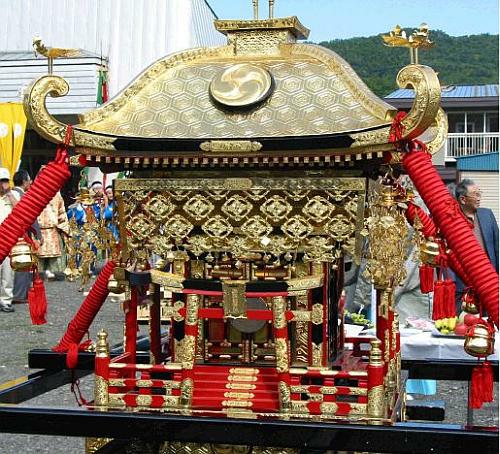 Shinto can also be said the religion of rituals or ceremonies mostly for purifications or exorcism, which can often be observed evenat the corporate society. Whenever a new factory manager was appointed, for example, he traditionally has to visit three places first thing he arrived at the assigned factory: A mini-shrine installed at a cozy corner of the factory grounds, where he says a prayer for the safety during his term of office; leaders of the factory's labor union to say hello and; chief of the local fishermen's association as the factories are usually located near the seacoast and likely to pollute the seawater with effluent.
Shinto can also be said the religion of rituals or ceremonies mostly for purifications or exorcism, which can often be observed evenat the corporate society. Whenever a new factory manager was appointed, for example, he traditionally has to visit three places first thing he arrived at the assigned factory: A mini-shrine installed at a cozy corner of the factory grounds, where he says a prayer for the safety during his term of office; leaders of the factory's labor union to say hello and; chief of the local fishermen's association as the factories are usually located near the seacoast and likely to pollute the seawater with effluent.
At the ground-breaking ceremony or at the start-up of new facility, be it a high-tech or a smoke-stack industry, a Shinto priest is always invited to perform the purification and exorcism rituals. Those are common Shinto-related customs practiced at any manufacturing plants in Japan. In case of Toyota Motor, just one example out of many, top executives play out corporate ritual every autumn at the Ise {e-seh} Grand Shrine in Mie Prefecture, the spiritual home of Sun Goddess Amaterasu, with their newest models, making three-hour driving from their headquarters near Nagoya. Shinto is thus firmly embedded in today's corporate society.
The Yomiuri, a leading daily newspaper in Japan (with a circulation of 10 million), once reported that a bogus organization billing itself as an association of Shinto priests has made a lucrative business out of sending retired workers disguised as priests to new building sites in Tokyo to conduct ground-breaking ceremonies. The fake priests have been dispatched on hundreds of occasions over three years, charging 40,000 yen per visit, which lasts only an hour or so. Of a customer's 40,000-yen (US$310) payment, the 'priest' earns 10,000 yen (US$77) and the group receives the remainder. To work officially as a priest, an individual must receive an appointment from the Association of Shinto Shrines, and yet there is no certification or qualification system.
We sometimes see the raging controversy over the governments' attitude toward Shinto when they donate money to shrines as offerings. A Prefectural government once paid 166,000 yen (US$1,280) of taxpayers' money on 22 occasions between 1981 and 1986 to Yasukuni {yah-soo-koo-nee} Shrine in Tokyo, which enshrines Japan's 2.6 million war-dead including World War II Class-A criminals such as the wartime Prime Minister. The payment was made to cover Tamagushi {tah-mah-goo-she} fee. Tamagushi is a sprig of Cleyera orchnacca with white paper-strips called 'shide' {she-deh} attached and used by Shinto priests at ceremonies. A citizen's group filed a lawsuit in 1982 against the governor charging that paying public funds to the Shinto shrine is unconstitutional. Article Twenty of the Constitution stipulates that the state and its organs shall refrain from religious education or any other religious activity. A lawyer for the defendants had said that the small cash offerings to the shrine represented condolences and were humanitarian courtesy to the 2.6 million war-dead. In April 1997, the Supreme Court ruled that the donation violated the Constitution. The ruling was supported by 13 judges of the 15-member Grand Bench of the Supreme Court.
Shinto ceremony sometimes marks life stages of the Japanese. One month after birth (31st day for boys and 32 days for girls, to be exact), parents and grand-parents bring him or her to a shrine, where they express gratitude to the Shinto deities for being given the baby and have shrine priest pray for his or her good health and happiness. This is called Miyamairi {me-yah-my-re}, or Visit to Shinto Shrine, a Japanese version of infant Baptism. Today, most of Miyamairi is practiced between one month or 100 days after birth. In famous and busy shrines, the ceremony is held every hour in turn. Naturally, weekends are busy. A group of a dozen or so babies and their families are usually brought in the hall, one group after another. There is no price list for the service. We usually pay 10,000 yen per baby. The group is led in by turn and sit in front of and facing the alter. A Shinto priest wearing unique Shinto costume and headgear appear between the group and the altar, and start to recite prayer or norito swinging Tamagushi right and left. We don't understand what he is saying except that somewhere in the middle of the prayer, the priest cites the name of the baby and his or her birthday. The prayer continue for about ten minutes. And then, parents carrying the baby go forward one by one and bow to the altar. In the end, sake, or rice wine, in a red wooden cup is given to each of them.
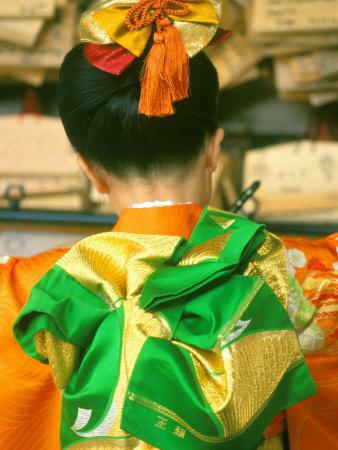 Next chance he or she may visit a shrine to mark the specific life stage is shichi-go-san {she-chee-goh-san} (seven-five-three) festival of November 15 when 3-year-old boys and girls, 5-year-old boys and seven-year-old girls (nominal age based on the calendar. In an extreme case, a baby born on December 31 will be two years old the next day) call on shrine to pray for good health and have blessing by the priest. In November 15, particularly on weekends near the day, you may see lots of children and their parents wearing colorful clothes or kimono in the precinct of famous shrines. They are visiting the shrines for the shichi-go-san ceremony.
Next chance he or she may visit a shrine to mark the specific life stage is shichi-go-san {she-chee-goh-san} (seven-five-three) festival of November 15 when 3-year-old boys and girls, 5-year-old boys and seven-year-old girls (nominal age based on the calendar. In an extreme case, a baby born on December 31 will be two years old the next day) call on shrine to pray for good health and have blessing by the priest. In November 15, particularly on weekends near the day, you may see lots of children and their parents wearing colorful clothes or kimono in the precinct of famous shrines. They are visiting the shrines for the shichi-go-san ceremony.
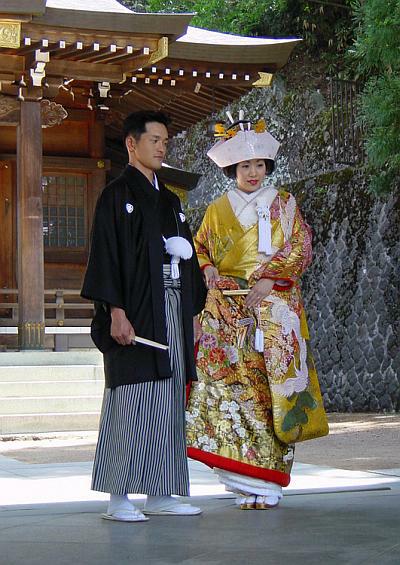 There are as many as 80,000 Shinto shrines in this country consecrating to one of the Shinto pantheon, but four are predominant: Hachimangu {hah-chee-man-goo}, Tenjin (also called Tenmangu), Inari {e-nah-re} and Jingu {gin-goo}.
There are as many as 80,000 Shinto shrines in this country consecrating to one of the Shinto pantheon, but four are predominant: Hachimangu {hah-chee-man-goo}, Tenjin (also called Tenmangu), Inari {e-nah-re} and Jingu {gin-goo}.- Hachimangu enshrines 15th Emperor Ojin, the de facto first emperor since all emperors before him were legendary. It is worshiped as the god of archery or war and later became a tutelary deity of the Minamoto Clan. Tsurugaoka Hachimangu ranks among the most prestigious ones and offers a wide array of Shinto rituals and ceremonies.
- Tenjin literally means the heaven's god, but is dedicated to the memory of Michizane Sugawara {me-chee-zah-neh soo-gah-wah-rah} (845-903), the patron deity of scholarship or learning. Egara Tenjin is one of the three greatest Tenjin in Japan.
- Inari is the shrine for the god of harvest and is popularly called fox deity since the fox is believed to be messengers of this god. Characteristic of this shrine is it multiple, vermilion torii gates and a pair of fox statues are placed in front of the shrine.
- Added to those are shrines called Jingu, which are associated with the Imperial Family. Most notable are: Meiji Jingu in Tokyo, Ise Jingu, Heian Jingu in Kyoto, Atsuta Jingu in Nagoya.
Shrine architecture
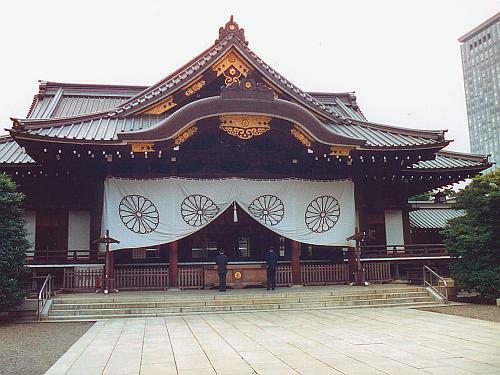 A full-fledged Shinto shrine is made of two-part structure as represented by the famous Nikko Toshogu Shrine in Tochigi Prefecture: one is the oratory called Haiden, before which worshipers say a prayer, and the other is the inner sanctum called Honden, the main dwelling of the deity built behind the Haiden. In contrast to Buddhist temples, Honden contains no statues but houses symbolical and sacred objects of worship such as mirrors and swords, in which the spirit of the deity is believed to reside. As its nature of sanctuary shows, the laity can never get access to the sacred Honden. Haiden is more spacious than Honden as it is used for rituals and ceremonies.
A full-fledged Shinto shrine is made of two-part structure as represented by the famous Nikko Toshogu Shrine in Tochigi Prefecture: one is the oratory called Haiden, before which worshipers say a prayer, and the other is the inner sanctum called Honden, the main dwelling of the deity built behind the Haiden. In contrast to Buddhist temples, Honden contains no statues but houses symbolical and sacred objects of worship such as mirrors and swords, in which the spirit of the deity is believed to reside. As its nature of sanctuary shows, the laity can never get access to the sacred Honden. Haiden is more spacious than Honden as it is used for rituals and ceremonies.
Torii Gate
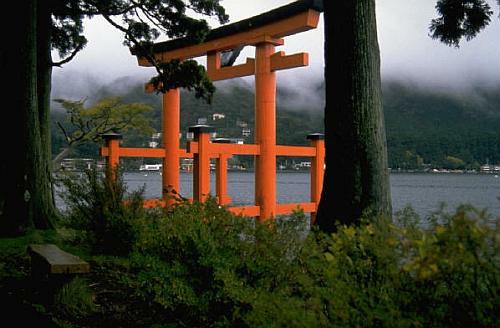 Shrines always have symbolic gates called torii {toh-re-e}. Worshipers will pass under this sacred gate, which demarcates the sacred area of the shrine. Because of its sacredness, it is difficult to deal with it. In the Haneda Airport in Tokyo, there was a 7.2-meter-high torii gate on a planned new runway. It was erected at the entrance of Anamori Inari Shrine before World War II. After the war, American Forces requisitioned the area and the shrine was moved. Fortunately, the torii was allowed to remain there in light of the local people's fear of punishment by Shinto deities. To construct a new runway, it has to be dismantled. Again, locals protested in fear that it might incur divine wrath. Government authority compromised, and decided, instead of dismantling, to relocate it to a bank of the Tama River about 800 meters away from the former site. However, it is unconstitutional for the government to cover the total cost for removing religious structures of a specific religion. After a long discussion, it was agreed that part of the total cost would be paid by private sectors, and the torii was finally relocated in February 1999.
Shrines always have symbolic gates called torii {toh-re-e}. Worshipers will pass under this sacred gate, which demarcates the sacred area of the shrine. Because of its sacredness, it is difficult to deal with it. In the Haneda Airport in Tokyo, there was a 7.2-meter-high torii gate on a planned new runway. It was erected at the entrance of Anamori Inari Shrine before World War II. After the war, American Forces requisitioned the area and the shrine was moved. Fortunately, the torii was allowed to remain there in light of the local people's fear of punishment by Shinto deities. To construct a new runway, it has to be dismantled. Again, locals protested in fear that it might incur divine wrath. Government authority compromised, and decided, instead of dismantling, to relocate it to a bank of the Tama River about 800 meters away from the former site. However, it is unconstitutional for the government to cover the total cost for removing religious structures of a specific religion. After a long discussion, it was agreed that part of the total cost would be paid by private sectors, and the torii was finally relocated in February 1999.
Purification
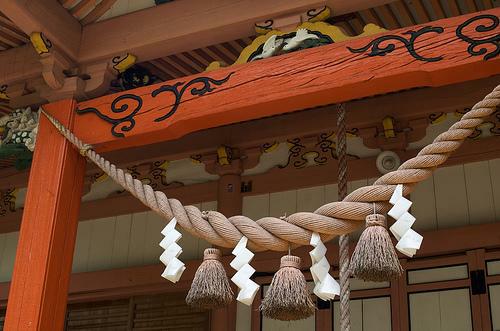 For a Shinto worshiper, purification is essential before offering a prayer and it is performed through exorcism called Harai {ha-rah-e}, cleaning one's body with water. It is called Misogi {me-soh-ghe}, and abstention from defilement or Imi {e-me}. In a large shrine, there is a stone wash-basin and visitors are required to rinse their mouth and hands for Misogi before approaching the deity.
For a Shinto worshiper, purification is essential before offering a prayer and it is performed through exorcism called Harai {ha-rah-e}, cleaning one's body with water. It is called Misogi {me-soh-ghe}, and abstention from defilement or Imi {e-me}. In a large shrine, there is a stone wash-basin and visitors are required to rinse their mouth and hands for Misogi before approaching the deity.
Shimenawa is a rope made by twisting together strands of rice straw. Shimenawa is used to mark a place considered sacred and cordon it off from the realm of the profane. It is traditionally thought to ward off evil and sickness. At Shinto shrines, shimenawa is hung in front of the main worship hall, before the altar, and across the entrance gate (torii). It is also hung on New Year's day over the doorways of private homes.
The paper shapes hanging from the shimenawa are one of the most noticeable things in Shinto. They are intended to keep out evil spirits and to signify that this is a holy place.
Komainu {koh-mah-e-noo}, or guard dogs
In front of shrines, there are a pair of dog-statues facing each other. They are guardian dogs and identical to Deva of Buddhist temples, one on the right always has its mouth open and as if to say 'ah' while the other has its mouth closed and looks like saying 'um.
Method of prayer
The method of prayer before the alter at shrines is quite distinct from that of Buddhist temples. As part of prayer ritual, worshipers bow twice, clap their hands twice (to make sure the god is listening?), bow once more and then (or before the prayer) throw coins into a wooden offertory box.
Kagura {kah-goo-rah}, or Shinto music and dancing
Kagura is a ritual dances accompanied by music called Gagaku {gah-gah-koo}. Gagaku is the traditional music of the Japanese Imperial Court, and standard instruments include sho (a reed-free mouth organ made of 17 bamboo), biwa {be-wah} (a short-necked lute), hichiriki {he-chee-re-key} (a double-reed pipe like a small oboe) and taiko {tye-ko} (drums). The Imperial Household Agency has the Imperial Ensemble and its musicians are hereditary dating from the ninth century. One of them is the Togi {toh-ghe} family and they are now employees of the Imperial Household Agency. Kagura and Gagaku are thought to help provide communications between the god and worshipers.
Liked this article? Dive deeper into personal growth and wellness! Check out CrystalWind.ca for spiritual wisdom or explore AromaWorx.ca for natural well-being tips. Spread the positivity—share this with friends on their happiness journey!
Let’s Chat! Drop Your Thoughts Below! ![]()
Latest Articles

Imagine a world of inspiration and healing, free for all—made possible by YOU!
Donate Now—Ignite the Magic at CrystalWind.ca!

Epilepsy - Finding A Cure
Your donation can make a difference!
Help us find a cure – donate now!
Unlock Your Light: Join Lightworkers Worldwide on CrystalWind.ca!
Articles: Shinto
Follow Us!
Featured This Month
Mabon in Modern Times: Fresh Takes on the Au…
The Mabon season begins somewhere around the 21st-22nd of September and cont... Read more
Sweet Violet
Sweet Violet Faithfulness and modesty. “I will always be true to you.” Helps... Read more
Crystals for Virgo
As the warmth of summer begins to soften into the crispness of autumn, the Sun... Read more
Virgo Mythology
The Virgo Myth In all of constellation mythology, few legends are as misund... Read more
The Vine: September 2nd - September 29th
The Autumnal Equinox ( Alban Elfed ) Celtic Symbol : The White Swan Read more
Peridot: The Healer's Stone
Peridot has been used as a Power Stone for centuries. Peridot fosters emotio... Read more
Mabon Magic: Ideas For Fall Decoration And R…
Welcome (almost!) to Fall! We’re turning the Great Wheel once again, toward ... Read more
Sun in Virgo
An Overview of Sun Sign Characteristics for Virgo Virgo is guided by Mercur... Read more
Watermelon Tourmaline
Synonym: Rainbow Tourmaline The watermelon tourmaline is a rare variety t... Read more












































